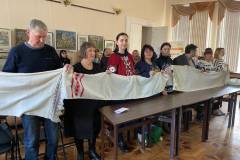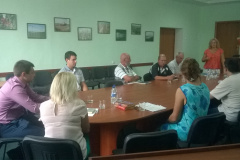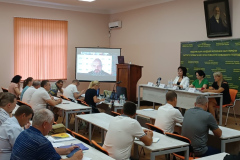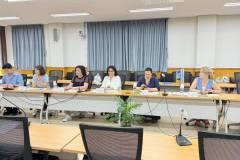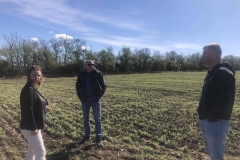Відділ селекції сільськогосподарських культур
Department of Agricultural Crop Breeding
Head of Department:

Tetiana MARCHENKO
Doctor of Agricultural Sciences, Professor
e-mail: tmarchenko74@ukr.net
Tel.: +380 95 442 9212
Main Research Areas
The department develops theoretical foundations for creating high-yielding soybean varieties, including vegetable-type soybeans, with high nitrogen-fixing capacity and adaptability to irrigation conditions in Southern Ukraine. In parallel, varietal cultivation technologies for these crops are being developed.
Breeding efforts focus on producing high-yield soybean varieties of different maturity groups, with seed yields of 3.0–3.5 t/ha for early-maturing types and 4.0–5.5 t/ha for medium-early and mid-season varieties, a growing season of 80–120 days, and high protein and oil content.
Agrobiological studies are conducted to evaluate breeding material and identify effective sources and donors of resistance in crops such as guar, okra, and beans.
Research has been initiated on chickpea breeding with the goal of developing high-tech, high-yield (3.0–4.0 t/ha), disease-resistant varieties of different maturity groups, with a growing season of 90–105 days, seed protein content of up to 25%, and oil content of up to 7%.
Breeding work is also carried out to create early-maturing cotton varieties with high fibre quality, along with improvements to cultivation techniques.
Key Scientific Achievements
Sources of earliness, high seed productivity, lodging resistance, tolerance to fungal, bacterial, and viral diseases, pod shattering resistance, and consistently high protein and oil content in soybean seeds have been identified. Based on this material, both independently and in collaboration with other research institutions, the department has developed soybean varieties of different maturity groups, which are listed in the State Register of Plant Varieties Suitable for Dissemination in Ukraine and abroad.
The early-maturing variety Diona was recognised for many years by the State Variety Testing Commission as the national standard in its maturity group. Currently, the most widely cultivated varieties include Diona, Phaeton, Danaia, Sofia, Sviatohor, and Monarch. New-generation varieties (Ravita, Zoria Stepu, Pivdenna Krasunia, Oleshshia), adapted to climate change, are currently undergoing state trials. Early-maturing varieties such as Diona, Monarch, and Ravita serve as reliable precursors for winter crops throughout Ukraine and, under irrigation, are recommended for post-harvest and stubble cropping.
Two medium-fibre cotton varieties—Dniprovskiy 5 and Pidozerskiy 4—have been registered in the State Register. These are domestically bred varieties specifically adapted to the Southern Steppe of Ukraine (high temperatures, drought, saline soils, limited irrigation). They are characterised by earliness, a growing season of 110–115 days, rapid boll opening on the first and second fruiting branches, and a fibre yield of 37–38%.
An innovative cotton cultivation technology has been developed, incorporating adaptive mineral nutrition, optimised sowing dates, reduced pesticide use, and resource-saving approaches. This reduces production costs by 30–50% compared to imported varieties, thanks to local seed production and minimal irrigation requirements (1–2 waterings per season).
Stable yields under stressful climatic conditions have been confirmed by many years of field research. It has been demonstrated that cotton can be grown as a monoculture for 3–4 consecutive years without yield loss. A comprehensive scientific support system has been developed—from seed production to harvesting and processing.
The implementation of this technology using domestic seed varieties provides a viable alternative to imported varieties—more cost-effective, reliable, and tailored to Ukraine’s needs. Combining breeding achievements with modern agrotechnology offers an effective pathway to revive cotton production in Ukraine and make it profitable for farmers in the near future.
Wheat Breeding
Main Research Areas
The department develops the theoretical foundations for breeding and creating short-stemmed and medium-height winter bread wheat varieties for irrigated and rainfed farming systems in the steppe and forest-steppe ecological zones of Ukraine. Fundamental research focuses on the genetics of traits and characteristics of winter wheat that determine the adaptive and productive potential of varieties, as well as grain quality.
A special focus is placed on modelling and developing winter bread wheat varieties for irrigated conditions with a yield potential of 8.0–10.0 t/ha. Under conditions of proper varietal agronomy, this yield potential can be realised at 95–100%.
Key Scientific Achievements
Winter bread wheat varieties Khersonska Bezosta, Khersonska 99, Ovidii, Kokhana, Blaho, Mariia, Konka, Burhunka, Anatoliia, Ledya, Koshova, Soborna, Perlyna Stepu, Akvillehiia, and Khersonska Fortetsia have been entered into the State Register of Plant Varieties of Ukraine. The variety Mariia is also registered in the State Register of Plant Varieties of Türkiye.
Under irrigated conditions, wheat varieties bred by the institute achieve yields of 9.5–12.0 t/ha. In rainfed systems, they produce 7.0–7.5 t/ha after fallow and 4.0–5.0 t/ha after non-fallow predecessors. These winter bread wheat varieties are characterised by high resistance to abiotic and biotic environmental factors, including low winter temperatures, high summer heat, and common phytopathogens in Ukraine such as powdery mildew, brown rust, fusarium head blight, and septoria. In terms of grain quality, the varieties are classified as strong or valuable wheat types.
Winter durum wheat varieties developed by the institute are high-yielding, sufficiently winter-hardy and drought-resistant. In southern Ukraine, they achieve yields of 7.5–8.5 t/ha on irrigated land and 5.0–6.5 t/ha in rainfed conditions after the best predecessors. These include Dniproiana, Kassiopeia, and Andromeda, all listed in the State Register of Plant Varieties Suitable for Dissemination in Ukraine.
Developments in both bread and durum wheat are protected by intellectual property rights, including 38 authorship certificates and 20 patents.
Alfalfa Breeding
Main Research Areas
The department focuses on developing new high-yielding alfalfa varieties with a complex of specific traits and properties tailored to production requirements.
Key Scientific Achievements
Research has identified correlations between morphobiotypic traits of the alfalfa root system and economically valuable characteristics, enabling more targeted selection based on root system architecture as a factor in improving soil fertility and structure, as well as increasing above-ground biomass productivity. Informative traits—such as the diameter of the main root and the total root system volume—have been determined to be associated with key indicators of overall plant productivity. These can serve as indirect selection criteria for enhancing root biomass accumulation and nitrogen-fixing capacity.
These developments have led to the creation of alfalfa varieties with powerful root systems, high productivity, and strong adaptive capacity, capable of accumulating 2.5–3.0 c/ha of biological nitrogen in the soil. A breeding methodology for increasing root biomass accumulation in alfalfa has been developed.
Research on biological nitrogen fixation at the institute focuses on studying the polymorphism of nitrogen-fixing productivity in alfalfa plants, identifying donors with high nitrogen-fixation activity, and using them to create varieties with improved nitrogen-fixing potential, as well as selecting highly efficient variety–strain symbiotic pairs.
In response to climate change, the creation of drought-tolerant alfalfa varieties has become a priority. Breeding efforts are underway to develop varieties with a combination of valuable traits—high forage, seed, and symbiotic productivity combined with drought resistance.
Ten alfalfa varieties—Nadiia, Sinska, Khersonska 9, Unitro, Veselka, Serafima, Zoriana, Anzhelika, Luiza, and Elegiia—have been entered into the State Register of Plant Varieties of Ukraine and granted the status of National Heritage of Ukraine.
Breeding work on sainfoin has begun, with initial material developed for creating new high-yielding varieties adapted to the southern region.
Breeding of new high-yielding perennial cereal grasses, maximally adapted to local conditions, is of great importance for strengthening the fodder base. As a result of breeding efforts, five competitive perennial cereal grass varieties of the southern ecotype have been developed for hayfields and pastures in the arid steppe of Ukraine, and have been entered into the State Register of Plant Varieties Suitable for Dissemination in Ukraine.








